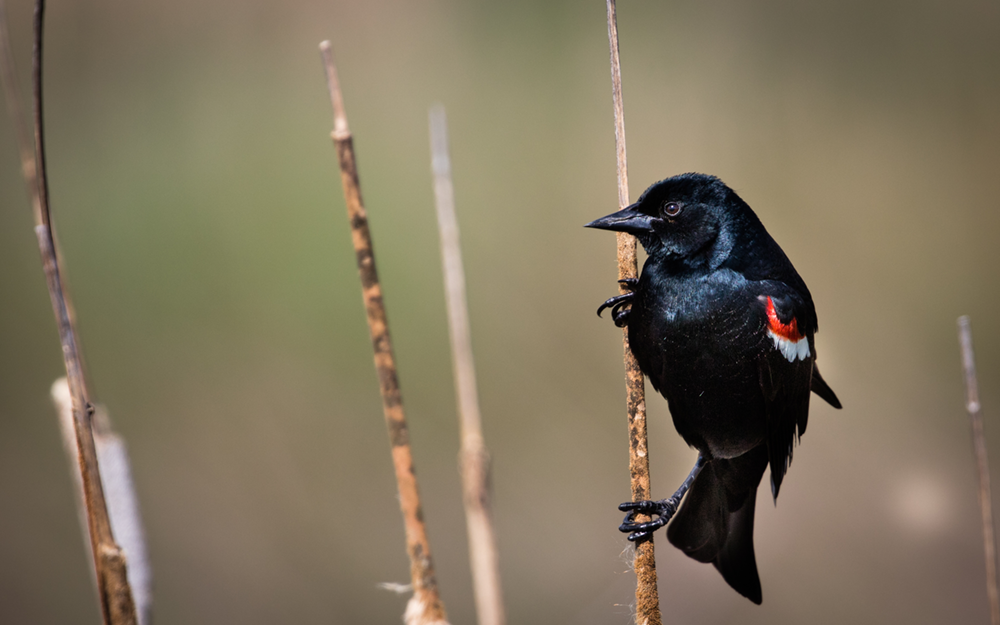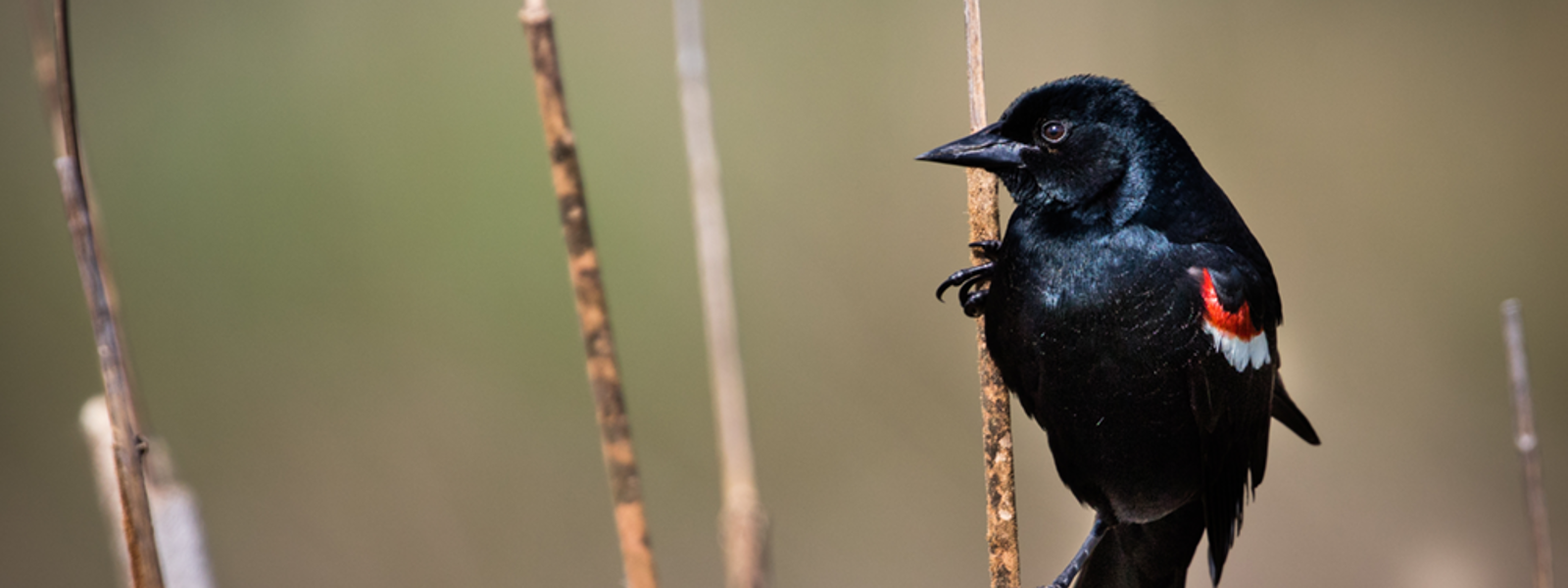Program to delay harvest protects birds and farmers

Listed as threatened under the California Endangered Species Act, tricolored blackbirds often build nests on dairy farmers’ forage crops due to loss of native habitat. To protect the birds and themselves from liability, farmers agree to delay harvest of their crops under a voluntary local program, which compensates them for crop losses due to the delay.
Photo/National Audubon Society

By Ching Lee
For multiple years, Simon Vander Woude’s Merced County dairy farm has served as a refuge for an imperiled bird species that has increasingly looked to agricultural fields as a nesting ground.
By agreeing to delay harvest where tricolored blackbirds nest, Vander Woude and other California farmers are helping to save a species that once faced potential extinction.
Tricolored blackbirds, which gained protection as threatened under the California Endangered Species Act in 2018, historically nested in freshwater marshes. But the loss of native wetland habitat has forced them to rely on winter silage fields planted by dairy farmers.
Because of the birds’ protected status, finding them in the field creates a hardship for farmers, as nesting season coincides with harvest and other farming activities.
To help protect the birds—and themselves from potential liability—farmers enter into a cooperative agreement to delay harvest until the birds have left their fields.
This year, Vander Woude and 13 other farmers impacted by the birds entered into such an agreement, known as the tricolored blackbird voluntary local program, or VLP.
The program protects farmers legally if birds are inadvertently killed or harmed during normal farming activity. It also compensates farmers for the loss of value of their crops that might result from the delay.
The VLP is administered through a cooperative agreement between the California Department of Fish and Wildlife, the U.S. Department of Agriculture Natural Resources Conservation Service and the California Farm Bureau. Audubon California and agricultural organizations including Western United Dairies partner in the program, which covers Stanislaus, San Benito, Merced, Madera, Fresno, Kings, Tulare and Kern counties.
Early estimates by CDFW show around 250,000 tricolored blackbirds across 15 colonies were protected this year because of the delayed harvest efforts. That’s up from an estimated 235,000 birds last year and 218,000 birds in 2022—and a marked improvement from 10 years ago, when bird numbers plunged to a low of 145,000.
“Overall, we view the program as a great success,” said Shannon Skalos, CDFW avian conservation coordinator.
With program enrollment and landowner participation continuing to rise, biologists have observed greater reproductive success for the protected birds—likely a significant driver of the increased population trends seen each year, Skalos added.
Although current bird numbers are encouraging, Skalos said they are still way off from the high count of 400,000 in 2008. But she said she expects to see the upward trend continue.
With glossy-black bodies and red and white patches on their wing shoulders, tricolored blackbirds are found almost exclusively in California. They form colonies that often exceed tens of thousands of birds, with populations in the millions during the early 20th century.
Because tricolors build their nests off the ground, they tend to look for plants that provide stability. On dairy farms, they prefer forage crops such as triticale, a hardy wheat-rye hybrid with a sturdy stem that doesn’t blow much in the wind.
On Vander Woude’s farm this year, upwards of 20,000 adult birds were seen nesting in one field, although most of them abandoned the colony in late March, likely due to adverse weather, said Ian Souza-Cole, a biologist for Audubon California, a state affiliate of the National Audubon Society. Some 1,000 birds stayed behind and bred, he added.
Because that colony finished relatively early, Vander Woude said his schedule was pushed back by only 10 to 15 days, allowing him to still irrigate and harvest the crop for silage. Other years, he had to wait as long as 30, 60 or 90 days before he could get in the field. Last year, for example, when as many as 35,000 breeding birds occupied one field and another colony of some 15,000 birds tied up another, he ended up having to disk the crop.
“It was a complete loss,” he said. “Some years, you’re able to salvage some of it, but it’s never exactly what you wanted to do to make ideal feed.”
Even though it’s called a voluntary local program, farmers with nesting tricolors don’t have much of a choice but to enroll, Vander Woude pointed out. Because the birds are protected, violations come with fines and potential jail time.
Without the cooperative agreement, farmers could be subjected to a complete stoppage of all farming practices and legal action if they impact the birds, and be responsible for all crop losses, said Amrith Gunasekara, director of science and research for the California Farm Bureau and a representative for the VLP.
“The VLP is unique in that it allows farmers to continue to farm the field while at the same time protect the tricolored blackbird, thereby eliminating legal action and allowing the farmer to be compensated for crop losses,” he said. “It’s a great example of how state agency programs can be built around certain regulations to be flexible enough that it achieves practical outcomes for both food production and protection of wildlife species.”
For most of the years he was affected, Vander Woude said participation in the program cost him “a lot of money,” especially during the drought, when crop values skyrocketed and finding feed on the market to replace what he couldn’t harvest was hard to come by.
On top of losing their winter silage crop, dairy farmers face additional delays planting their summer corn crop, said Paul Sousa, environmental services director for Western United Dairies.
“The later you plant your corn, the lower the yield,” he said, noting impacts to corn yield represent a greater loss to farmers hosting tricolored blackbirds.
Xeronimo Castaneda, working lands program director for Audubon California, which works to secure funding for farmers and provides them technical support, acknowledged his organization has grappled with how to structure payments to offset farmers’ losses.
In the early days of launching the program—which dates back more than a decade before the birds were listed as threatened—there was not much funding to pay farmers at all, Castaneda noted. Knocking on their doors to ask them to delay harvest was much more difficult, he said, “because they’re trying to feed their cows, and we’re asking these folks to do something that is not farming.”
That changed as the program became more established and USDA-NRCS agreed to fund it. But producer compensation initially focused only on impacts to the winter forage crop and did not account for other consequences such as disruptions to summer planting.
After working with a dairy economics firm last year, the program now has a more accurate formula for calculating farmer payments, Castaneda said. In addition, CDFW has since chipped in to boost producer compensation, which totaled $1,600 per acre last year and this year.
Dairy farmer Vander Woude said even though the payments in most years still do not offset all his losses, the program has “gotten closer to being fair.” With feed costs lower this year, “the program worked, and I didn’t lose money on it,” he added.
“We don’t get everything we want, but they are listening and trying to make it an effective program,” Vander Woude said.
The program’s long-term sustainability remains a concern, Sousa of Western United Dairies said. Though the grant from USDA-NRCS is locked in, CDFW’s share is tied to the state budget and must be negotiated every year.
“What I would love more than anything is to have some perpetual funding that we know is going to be there,” Sousa said.
CDFW’s Skalos said long-term funding remains a challenge and may continue to be so, especially as bird populations increase along with the number of colonies found on dairies.
“But we are committed to the long-term protection of the species, as well as maintaining the positive partnerships with landowners and the dairy industry that have resulted from this program,” she said, adding that the department will work with state leadership to identify funding and long-term solutions to tricolored blackbird conservation.
(Ching Lee is an assistant editor of Ag Alert. She may be contacted at clee@cfbf.com.)




